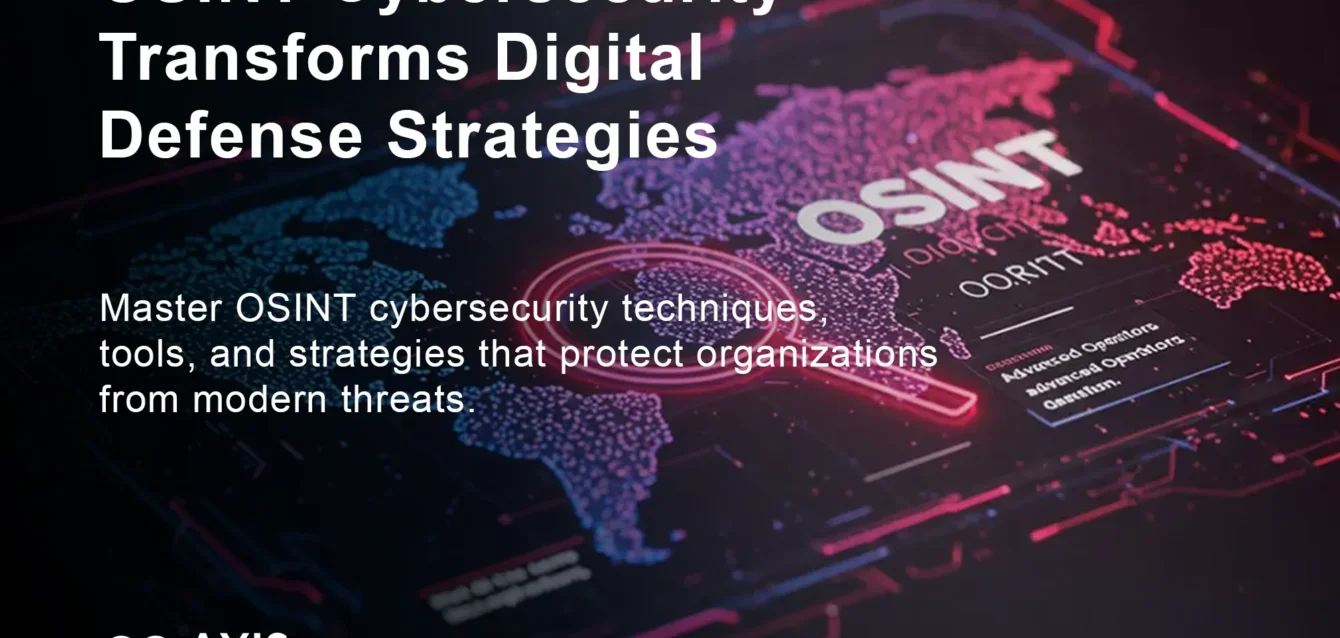The cybersecurity landscape has evolved dramatically, and traditional defense mechanisms alone can no longer protect organizations from sophisticated threat actors. The global Open Source Intelligence (OSINT) market was valued at USD 8.69 billion in 2024 and is projected to reach USD 46.12 billion by 2034, growing at a CAGR of 18.01%, highlighting the critical role OSINT plays in modern cybersecurity defense.
What if you could predict attacks before they happen? What if you could turn publicly available information into your strongest defense weapon? Welcome to the world of OSINT cybersecurity, where intelligence gathering meets proactive defense in ways that would have seemed impossible just a few years ago.
This comprehensive guide reveals how cybersecurity professionals leverage open source intelligence to build impenetrable defense systems, detect threats in real-time, and stay ahead of cybercriminals who increasingly rely on the same techniques for reconnaissance.
Índice
- Understanding OSINT in Cybersecurity Context
- The Dual Nature of OSINT: Sword and Shield
- Essential OSINT Tools for Cyber Defense
- Threat Intelligence Through Open Sources
- Proactive Defense Strategies Using OSINT
- Attack Surface Management and Vulnerability Assessment
- Social Engineering Defense Through OSINT
- Dark Web Monitoring and Intelligence
- Real-Time Threat Detection Systems
- Building an OSINT-Powered Security Operations Center
- Consideraciones jurídicas y éticas
- Advanced OSINT Techniques for Enterprise Security
- Case Studies: OSINT in Action
- Tendencias futuras y tecnologías emergentes
- Hoja de ruta para las organizaciones
Understanding OSINT in Cybersecurity Context {#understanding-osint}
Código abierto Intelligence in cybersecurity isn’t just about gathering information – it’s about transforming publicly available data into actionable security intelligence that strengthens organizational defenses. OSINT refers to the process of collecting and analyzing publicly accessible data to uncover potential threats and security risks.
Think of OSINT as your organization’s early warning system. While attackers spend weeks or months conducting reconnaissance using these same techniques, defenders can use OSINT to understand their own attack surface and identify vulnerabilities before they’re exploited.
The intelligence community has recognized this shift. In December 2005, the Director of National Intelligence appointed Eliot A. Jardines as the Assistant Deputy Director of National Intelligence for Open Source to serve as the Intelligence Community’s senior intelligence officer for open source, establishing OSINT as a critical national security capability.
The Modern Threat Landscape
Today’s cybercriminals are sophisticated researchers. They use OSINT to:
- Map organizational structures and identify key personnel
- Discover exposed assets and vulnerable systems
- Craft targeted phishing campaigns
- Understand business operations and critical dependencies
- Identify supply chain vulnerabilities
Understanding these attack vectors is crucial because cybersecurity experts, as well as cybercriminals, try and gather as much information as is publicly available about an organisation, asset or individual as they can, so as to use the information gathered to their advantage.
The Dual Nature of OSINT: Sword and Shield {#dual-nature}
OSINT operates as both an offensive and defensive tool in cybersecurity. OSINT is a double-edged sword, with both attackers and defenders harnessing its power. While attackers seek vulnerabilities and sensitive data, defenders use OSINT to strengthen their security posture, enhance threat awareness, and protect against potential threats.
Defensive Applications
For cybersecurity professionals, OSINT serves multiple defensive functions:
Threat Hunting: Proactively searching for indicators of compromise across open sources helps identify threats before they fully materialize. Security teams monitor forums, paste sites, and social media for mentions of their organization or leaked credentials.
Attack Surface Discovery: OSINT aims to reveal public information about internal assets and other information accessible outside the organization. This includes identifying exposed databases, unprotected cloud storage, and misconfigured services.
Brand Protection: Monitoring for domain spoofing, fake social media accounts, and fraudulent websites helps protect organizational reputation and customer trust.
The Attacker’s Perspective
Understanding how attackers use OSINT is essential for effective defense. Cyber threat actors employ open-source intelligence tools and methods to pinpoint possible targets and exploit vulnerabilities in their target networks.
Attackers typically follow a reconnaissance methodology:
- Passive information gathering from search engines and social media
- Technical reconnaissance using tools like Shodan and DNS enumeration
- Social engineering preparation based on gathered intelligence
- Infrastructure mapping and vulnerability identification
Essential OSINT Tools for Cyber Defense {#essential-tools}
The OSINT toolkit for cybersecurity professionals has expanded significantly. Here are the most effective tools for defensive operations:
Search and Discovery Tools
Shodan: Dubbed the “search engine for the Internet of Things,” Shodan allows users to discover internet-connected devices, including servers, routers, and webcams. For defenders, Shodan helps identify exposed organizational assets and services that shouldn’t be public-facing.
Censys: Similar to Shodan, Censys provides internet-wide scanning data that helps organizations understand their external attack surface. It’s particularly valuable for identifying SSL certificates, open ports, and service configurations.
Google Dorking: Advanced search operators remain one of the most powerful OSINT techniques. Queries like site:yourcompany.com filetype:pdf can reveal sensitive documents accidentally indexed by search engines.
Intelligence Aggregation Platforms
Maltego: Maltego is part of the Kali Linux operating system, commonly used by network penetration testers and hackers. It is open source, but requires registration with Paterva, the solution vendor. For cybersecurity teams, Maltego visualizes relationships between entities, helping map threat actor infrastructure and understand attack patterns.
SpiderFoot: SpiderFoot is an automated OSINT collection tool that aggregates intelligence from over 100 different sources. It scans domains, IP addresses, and email addresses, generating detailed reports on potential risks or threats.
ThreatCrowd: This tool aggregates threat intelligence data from multiple sources, allowing security teams to investigate suspicious domains, IP addresses, and file hashes.
Specialized Security Tools
VirusTotal: VirusTotal is a web platform founded in 2004 as a service for analyzing files and URLs for viruses, worms, trojans, and other types of malicious content. Over the years, it has added support for more than 80 antivirus engines. Beyond malware detection, VirusTotal provides valuable intelligence about file relationships and distribution patterns.
Have I Been Pwned: Essential for monitoring credential breaches that could affect organizational security. Regular monitoring helps identify when employee credentials appear in data dumps.
Threat Intelligence Through Open Sources {#threat-intelligence}
Modern threat intelligence relies heavily on OSINT to provide context and attribution for cyber threats. OSINT is applied to threat detection, risk assessment, and vulnerability management in cybersecurity. Threat intelligence teams track open sources for indicators of data breaches, phishing pages, leaked credentials, and new cyber threats.
Building Intelligence Feeds
Effective threat intelligence requires multiple data sources:
Underground Forums: Monitoring cybercriminal forums provides early warning of planned attacks, new malware releases, and compromised credentials. However, this requires specialized tools and careful operational security.
Social Media Intelligence: Social Media Intelligence, which is acquired from viewing or observing a subject’s online social profile activity, helps identify threats against executives and early indicators of social engineering campaigns.
Code Repositories: Monitoring GitHub, GitLab, and other platforms for accidentally exposed credentials, API keys, and sensitive configuration files is crucial for preventing data breaches.
Indicators of Compromise (IOC) Discovery
OSINT sources provide valuable IOCs that enhance detection capabilities:
- Domain registration patterns linked to known threat actors
- SSL certificate reuse across malicious infrastructure
- Code similarities in malware samples
- Communication patterns in command and control networks
Proactive Defense Strategies Using OSINT {#proactive-defense}
Traditionally, cybersecurity focused mainly on protecting internal systems and reacting to network-based attacks. With the proliferation of OSINT, security professionals now can proactively gather information about potential threats and attackers, and take a more proactive approach to security.
Sistemas de alerta rápida
Implementing OSINT-based early warning systems helps organizations detect threats before they impact operations:
Domain Monitoring: Track newly registered domains that could be used for phishing or malware distribution. Tools like URLVoid and DomainTools provide automated monitoring capabilities.
Certificate Transparency Logs: Monitor CT logs for suspicious SSL certificates that might indicate impersonation attempts or infrastructure preparation by threat actors.
Análisis de infraestructuras: Analyzing reused infrastructure, subject lines, and delivery tactics helps identify likely targets within your organization.
Predictive Threat Analysis
Advanced OSINT techniques enable predictive threat analysis:
- Monitoring threat actor communications for targeting discussions
- Analyzing geopolitical events that might trigger cyber campaigns
- Tracking vulnerability discussions in security research communities
- Correlating attack patterns with business events or announcements
Attack Surface Management and Vulnerability Assessment {#attack-surface}
One of OSINT’s most valuable applications in cybersecurity is comprehensive attack surface management. useful information that can be revealed through OSINT includes open ports; unpatched software with known vulnerabilities; publicly available IT information such as device names, IP addresses and configurations; and other leaked information belonging to the organization.
External Asset Discovery
Organizations often lose track of their external-facing assets. OSINT helps discover:
Shadow IT: Cloud services, domains, and applications deployed without IT oversight. Tools like Spyse and SecurityTrails help identify all subdomains and services associated with organizational domains.
Third-Party Exposures: Vendors and partners may also be sharing specific details about an organization’s IT environment. Regular monitoring of partner websites and documentation can reveal sensitive architectural information.
Historical Footprints: The Wayback Machine and other archives might contain sensitive information that was previously public but has since been removed from live sites.
Vulnerability Intelligence
OSINT provides crucial intelligence about vulnerabilities affecting organizational assets:
- CVE databases and security advisories
- Proof-of-concept exploit code availability
- Active exploitation discussions in security communities
- Vendor-specific vulnerability feeds and patches
Social Engineering Defense Through OSINT {#social-engineering}
Social engineering attacks increasingly rely on OSINT for preparation and targeting. Threat actors can use OSINT to gather information about the target’s physical location, such as the location of their offices or data centers, the area they live in, what kind of car they drive and much more. This information can be used to launch convincing phishing or social engineering campaigns against individuals.
Programas de protección de ejecutivos
High-value targets require specialized OSINT-based protection:
Digital Footprint Analysis: Regular assessment of executive online presence helps identify information that could be used for targeting. This includes social media activity, professional profiles, and public speaking engagements.
Family and Associate Monitoring: Extended monitoring of family members and close associates can prevent indirect targeting attempts.
Behavioral Pattern Analysis: Understanding communication patterns and relationships helps identify anomalous contact attempts.
Employee Awareness Through OSINT
Organizations can use OSINT to demonstrate social engineering risks to employees:
- Show employees what information is publicly available about them
- Demonstrate how this information could be used in attacks
- Provide personalized security recommendations based on individual risk profiles
Dark Web Monitoring and Intelligence {#dark-web}
The dark web represents a critical intelligence source for cybersecurity professionals. We’ll also take a deep dive into the dark web, covering how it works, how we can find things, and what we can expect to find. We’ll examine a case study of breach data hitting the dark web.
Monitoring Criminal Activities
Dark web monitoring provides early warning of threats:
Credential Markets: Monitoring for organizational credentials in underground markets helps identify breaches before they’re publicly disclosed.
Ransomware Groups: Tracking ransomware group communications and victim listings provides threat intelligence and helps predict targeting patterns.
Malware Markets: Understanding available malware and exploit tools helps security teams prepare appropriate defenses.
Operational Security Considerations
Dark web intelligence gathering requires careful operational security:
- Use of VPNs and anonymization tools
- Isolated research environments
- Legal compliance with monitoring activities
- Protection of investigator identities
Real-Time Threat Detection Systems {#real-time-detection}
Modern OSINT cybersecurity implementations require real-time processing capabilities. By correlating OSINT feeds with threat intelligence platforms such as SentinelOne, security teams can identify and block threats in real time—typically before the attackers can execute their plans.
Automated Collection and Analysis
Real-time systems must handle massive data volumes:
Integración API: Most OSINT tools provide APIs for automated data collection. Integration with SIEM systems enables real-time alerting on suspicious indicators.
Machine Learning Enhancement: AI-powered OSINT tools automate threat, pattern, and anomaly detection across diverse datasets, making data analysis significantly more efficient.
Stream Processing: Technologies like Apache Kafka and Elasticsearch enable real-time processing of OSINT feeds for immediate threat detection.
Alert Prioritization
Effective real-time systems must prioritize threats appropriately:
- Risk scoring based on asset criticality and threat severity
- Correlation with internal security events
- Automated response capabilities for high-confidence threats
- Human analyst escalation for complex scenarios
Building an OSINT-Powered Security Operations Center {#soc-integration}
Integrating OSINT capabilities into Security Operations Centers (SOCs) requires careful planning and implementation. Tirexdel brings together all major security vendors for OSINT and threat intelligence analysis in a single tool. Its usefulness in a SOC environment allows a security analyst to streamline and automate processes during incident handling.
Analyst Workflow Integration
OSINT tools must integrate seamlessly into existing SOC workflows:
Incident Response Enhancement: During incident response, OSINT provides additional context about threat actors, attack methods, and potential attribution. Tools like Maltego help visualize attack infrastructure and identify related indicators.
Threat Hunting Automation: Automated OSINT collection enables proactive threat hunting by continuously searching for indicators of compromise across open sources.
Case Management Integration: OSINT findings must be properly documented and integrated into case management systems for future reference and pattern analysis.
Formación y capacitación
SOC teams require specialized OSINT training:
- Understanding of various OSINT sources and their reliability
- Operational security practices for intelligence gathering
- Legal and ethical considerations in OSINT collection
- Tool-specific training for specialized platforms
Legal and Ethical Considerations {#legal-ethical}
OSINT operations must comply with legal requirements and ethical standards. Most organizations are covered by the General Data Protection Regulation (GDPR) or other privacy regulations. OSINT very commonly collects personal data, which can be defined as personally identifiable information (PII).
Cumplimiento de la normativa
Different jurisdictions have varying requirements for OSINT activities:
Cumplimiento del GDPR: European organizations must ensure OSINT activities comply with data protection regulations, including legitimate interest assessments and data minimization principles.
Sector-Specific Regulations: Financial services, healthcare, and government organizations face additional compliance requirements that affect OSINT operations.
Cross-Border Considerations: International OSINT operations must consider the legal framework of each jurisdiction involved.
Ethical Guidelines
Overall, it’s important for professionals to keep ethics at the top of mind when conducting OSINT investigations. While there are clear laws around computer misuse, the main feature of OSINT is the ability to gain an edge over an organisation, asset or individual.
Organizations should establish clear ethical guidelines for OSINT activities:
- Proportionality between security needs and privacy impact
- Transparency about OSINT capabilities and their use
- Regular review of OSINT practices and policies
- Staff training on ethical intelligence gathering
Advanced OSINT Techniques for Enterprise Security {#advanced-techniques}
Enterprise-level OSINT operations require sophisticated techniques and technologies. Group-IB’s Digital Risk Protection enhances OSINT cybersecurity by actively monitoring digital risks across the Internet, including brand abuse, data leaks, and the exposure of sensitive information.
Infrastructure Analysis and Attribution
Advanced OSINT techniques enable detailed infrastructure analysis:
Passive DNS Analysis: Historical DNS records help map threat actor infrastructure and identify patterns across multiple campaigns.
SSL Certificate Tracking: Certificate reuse and patterns help attribute attacks to specific threat actors and predict future infrastructure.
Network Topology Mapping: Understanding the network relationships between malicious domains and IP addresses helps identify command and control infrastructure.
Behavioral Analysis
Sophisticated threat actors can be identified through behavioral analysis:
- Communication patterns in forums and social media
- Operational security mistakes and personal information leakage
- Timing patterns that reveal geographic location or work schedules
- Technical capabilities demonstrated through tool usage and code analysis
Case Studies: OSINT in Action {#case-studies}
Real-world examples demonstrate the power of OSINT in cybersecurity defense:
SolarWinds Breach Investigation
OSINT played a crucial role in unraveling the scope and methods of the 2020 SolarWinds breach. This advanced supply chain compromise was quickly attributed to the Russian-sponsored group APT29: the hackers had accessed the SolarWinds network, injected a malicious code called SUNBURST.
OSINT contributed to the investigation through:
- Analysis of domain registration patterns
- Infrastructure correlation with known APT29 operations
- Timeline reconstruction using public data sources
- Victim identification through network analysis
Hafnium Exchange Server Attacks
Chinese APT group ‘Hafnium’ was a state-sponsored group targeting infectious disease researchers, law firms, higher education institutions, defense contractors, policy think tanks, and NGOs to exfiltrate data from structurally vital Microsoft Exchange and 365 servers.
The defensive response leveraged OSINT to:
- Share indicators of compromise across the security community
- Identify additional victims through infrastructure analysis
- Track the evolution of attack techniques
- Coordinate international response efforts
Corporate Espionage Prevention
A Fortune 500 technology company used OSINT to identify and prevent corporate espionage:
- Monitoring competitor job postings for suspicious hiring patterns
- Tracking employee social media for signs of recruitment attempts
- Analyzing patent filings and research publications for intelligence gathering
- Identifying supply chain risks through vendor analysis
Future Trends and Emerging Technologies {#future-trends}
The future of OSINT cybersecurity is being shaped by several key trends:
Integración de la Inteligencia Artificial
AI and automation are transforming OSINT capabilities, enhancing real-time threat detection and intelligence analysis across cybersecurity and geopolitical domains.
AI will revolutionize OSINT through:
- Natural language processing for social media and forum analysis
- Computer vision for image and video intelligence
- Pattern recognition for threat actor attribution
- Automated report generation and threat briefings
Quantum Computing Implications
Quantum computing will impact OSINT in multiple ways:
- Enhanced cryptographic analysis capabilities
- Improved pattern recognition in large datasets
- New vulnerabilities in current encryption methods
- Changes in privacy and anonymization technologies
Blockchain and Cryptocurrency Intelligence
The growth of blockchain technologies creates new OSINT opportunities:
- Transaction analysis for financial crime investigation
- Smart contract vulnerability assessment
- Decentralized infrastructure monitoring
- Cryptocurrency-based threat actor tracking
Implementation Roadmap for Organizations {#implementation}
Successfully implementing OSINT cybersecurity capabilities requires a structured approach:
Fase 1: Evaluación y planificación (Meses 1-2)
Análisis del estado actual: Assess existing intelligence capabilities and identify gaps in coverage. This includes reviewing current tools, processes, and staff skills.
Requirements Definition: Define specific OSINT objectives based on organizational risk profile and threat landscape. Consider regulatory requirements and budget constraints.
Tool Selection: Evaluate and select appropriate OSINT tools based on requirements and budget. Consider both commercial and open-source options.
Phase 2: Infrastructure Development (Months 3-4)
Infraestructura técnica: Deploy selected tools and integrate with existing security infrastructure. Ensure proper network segmentation and access controls.
Data Management: Establish data collection, storage, and retention policies. Implement proper backup and disaster recovery procedures.
Security Measures: Implement operational security measures to protect OSINT activities and maintain investigator anonymity.
Phase 3: Process Development (Months 5-6)
Standard Operating Procedures: Develop comprehensive SOPs for OSINT collection, analysis, and dissemination. Include quality assurance and review processes.
Integración de flujos de trabajo: Integrate OSINT capabilities into existing security operations workflows, including incident response and threat hunting.
Legal and Compliance Framework: Establish legal review processes and compliance procedures for OSINT activities.
Phase 4: Training and Operations (Months 7-8)
Staff Training: Provide comprehensive training on OSINT tools, techniques, and legal considerations. Include hands-on practice with real-world scenarios.
Operational Testing: Conduct testing of OSINT capabilities against known threats and scenarios. Refine processes based on testing results.
Métricas de rendimiento: Establish metrics for measuring OSINT effectiveness and return on investment.
Phase 5: Optimization and Scaling (Months 9-12)
Mejora continua: Regularly review and optimize OSINT processes based on operational experience and threat evolution.
Advanced Capabilities: Implement advanced techniques such as machine learning and automated analysis as organizational maturity increases.
Knowledge Sharing: Participate in threat intelligence sharing communities and establish information sharing partnerships.
Preguntas frecuentes
What is the difference between OSINT and traditional cybersecurity monitoring?
OSINT focuses on gathering intelligence from publicly available sources outside your organization’s direct control, while traditional monitoring examines internal systems and networks. OSINT provides external context and early warning capabilities that complement internal security measures.
How much does implementing OSINT cybersecurity cost?
Costs vary significantly based on organizational size and requirements. Basic implementations using free tools might cost $10,000-50,000 annually in staff time, while enterprise solutions with commercial tools and dedicated staff can cost $500,000-2,000,000 annually.
What are the biggest legal risks in OSINT operations?
The primary legal risks include privacy violations, unauthorized access to systems, and non-compliance with data protection regulations like GDPR. Organizations must ensure their OSINT activities remain within legal boundaries and comply with applicable regulations.
How can small organizations benefit from OSINT cybersecurity?
Small organizations can start with free tools like Google dorking, Have I Been Pwned monitoring, and basic social media monitoring. Many threats can be identified using simple techniques before investing in commercial solutions.
What skills do staff need for OSINT cybersecurity roles?
Essential skills include information research techniques, understanding of internet technologies, basic programming for automation, analytical thinking, and knowledge of legal and ethical considerations. Communication skills are also important for report writing and briefings.
How do you measure the effectiveness of OSINT programs?
Key metrics include the number of threats identified before impact, reduction in successful social engineering attacks, time to threat detection, and cost savings from prevented incidents. Qualitative measures include improved situational awareness and enhanced decision-making.
What’s the relationship between OSINT and threat intelligence platforms?
OSINT provides raw intelligence that feeds into threat intelligence platforms for analysis, correlation, and dissemination. Modern threat intelligence platforms often include OSINT collection capabilities and can automatically process open source feeds.
How often should organizations conduct OSINT assessments?
Continuous monitoring is ideal for high-risk organizations, while others might conduct quarterly or semi-annual assessments. The frequency should align with organizational risk tolerance and the dynamic nature of the threat landscape.
Transform Your Cybersecurity Defense with OSINT
The cybersecurity landscape demands proactive, intelligence-driven defense strategies. OSINT provides the eyes and ears that traditional security tools cannot offer, enabling organizations to detect threats before they strike and understand attack patterns before they unfold.
With synthetic-identity fraud expected to exceed USD 5 billion globally in 2025, banks channel budgets into real-time dark-web analytics and social-engineering detection, demonstrating the critical importance of OSINT in modern defense strategies.
The organizations that will thrive in 2025 and beyond are those that embrace OSINT as a core component of their cybersecurity strategy. The question isn’t whether you can afford to implement OSINT cybersecurity – it’s whether you can afford not to.
Ready to transform your cybersecurity posture? Start with a comprehensive OSINT assessment of your organization’s external footprint. You might be surprised by what you discover – and what your adversaries already know.





